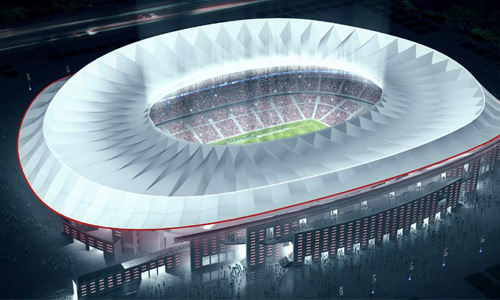Let’s remember for a moment our life before the pandemic: What was it like to be at a concert or a football match? When thousands of people meet at the same location? In “normal” times, these kinds of events require reliable mobility and safety concepts – which include pedestrian simulations.
The re-opening of the Metropolitano Stadium of Madrid in 2017 was no difference. A detailed crowd simulation was carried out to guarantee a safe, efficient, and smooth flow of visitors at the venue.

The Estadio Wanda Metropolitano was rebuilt from 2011 to 2017. The aim was to turn it into a football-only stadium by removing the athletics tracks and expanding the capacity from 20,500 to almost 70,000 visitors.
To ensure that such large crowds can enter, exit, and move around in the stadium safely, a pedestrian simulation study was conducted even before reconstruction started. This provided valuable guidance to the designers on how to build a safe infrastructure in the renewed stadium.
Pedestrian flow under normal operating conditions
Spanish modeler Javier Flores, who at the time worked for consultancy Prointec, was responsible for this study. He built a model using PTV Viswalk software and carried out the ingress and egress scenarios.
Javier Flores explains: “In the crowd simulation we focused on visitor flows under normal operating conditions at a maximum occupancy level – evacuation scenarios were not required at this stage. We looked at different questions. For example: What happens at the entry gates and turnstiles when up to 70,000 people want to enter or exit the stadium? How can the accessibility to the fan zone stage be best guaranteed? Where should commercial areas or children’s playground be best located?”
The connection to nearby car parks, metro stations, and bus stops was another important aspect of the crowd simulation. When 70,000 people arrive at the same time for an event, the road and transportation network of a city can quickly reach its limits.
Flores adds: “We analyzed the entire precinct area, identifying the critical points, where the highest pedestrian density peaks occurred, including bottlenecks. The most relevant metric used was the Level of Service (LOS), based on Fruin´s analysis – a concept to define the pedestrian densities and quality of pedestrian flow meaning how well, fluidly, quickly people can move”.
Identifying those critical points and areas, enabled the project team to find solutions and measures to overcome them. For example, by extending the stairs at the access area of public transport or by changing the location of commercial areas to a more suitable place.
Powerful tool: Crowd Simulation
The findings from the pedestrian simulation were considered in the reconstruction plans for the sports facility. Since 2017, Atlético Madrid has been playing in its new home stadium.
Javier Flores concludes: “Crowd simulations are powerful tools. They allow us to assess the detailed operation of any infrastructure prior to its implementation under realistic conditions. At Buchanan, where I work today, we are combining our knowledge on pedestrian behavior with the use of the latest simulation techniques and software solutions. Our projects range from major events to pedestrian flow analysis for rail and metro stations e.g., the Lima and Riyadh Metro. Pedestrian simulations allow us to predict people’s behavior in a particular space, under a wide variety of conditions, in all types of spatial and operational arrangements.”



